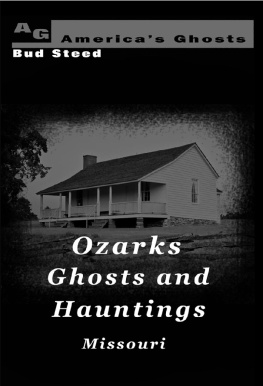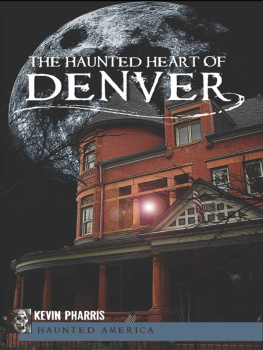

Published by Haunted America
A Division of The History Press
Charleston, SC 29403
www.historypress.net
Copyright 2012 by Bud Steed
All rights reserved
First published 2012
e-book edition 2012
Manufactured in the United States
ISBN 978.1.61423.683.2
Library of Congress CIP data applied for.
print ISBN 978.1.60949.639.5
Notice: The information in this book is true and complete to the best of our knowledge. It is offered without guarantee on the part of the author or The History Press. The author and The History Press disclaim all liability in connection with the use of this book.
All rights reserved. No part of this book may be reproduced or transmitted in any form whatsoever without prior written permission from the publisher except in the case of brief quotations embodied in critical articles and reviews.
CONTENTS
DEDICATION AND ACKNOWLEDGEMENTS
This book is dedicated to my wife, Jennifer Lynn Steed, who has never, over the years that we have spent together, lost faith in me, even when I have lost faith in myself. She has always been my constant cheerleader, offering words of encouragement and a hug and a kiss in those moments when I doubted myself and my abilities and always patiently waiting while I chased after one dream or another. She is my rock, and I love her for it.
To my kids, David, Sean, Ciara Jo and Kerra Lynn, I thank you for your understanding and patience when I was too busy writing and researching to throw the baseball or football with you or to simply hang out and watch Tinkerbell and the Great Fairy Rescue movie with you (after about the fortieth time, I can effectively quote the good parts by heart). Watching you guys grow and become the fine young men and ladies that you are is truly gratifying and a testament to your mothers hard work at raising you correctly. Its not easy being my kids, but you manage it well, and I love you all more than life itself.
To my oldest daughter, Bobbi Jo, I miss you constantly, and not a day passes that I dont think of you or wonder what your life would have been like. Rest in peace, sweetie. We all love and miss you.
To my good friend David Harkins, who is also the founder and director of our paranormal investigation team, The Ozarks Paranormal Society, thanks for always having my back and for always being ready to help, even on short notice.
To my parents, Merlin Sr. and Rose Steed, I thank you for never giving up on me even though I gave you ample reasons to do so. Your encouragement, love and forgiveness over the years are greatly appreciated, and I can only hope that I end up being half the parent to my children that you two were to me; I love you guys.
I would like to acknowledge the help that I have received while researching and writing this book. Thanks to Dave Harkins for riding along on the trip to the coast for photos and video for this book and for my websites. Your help was much appreciated, brother. Also, thanks to Jennifer for helping proofread the rough draft, for keeping me on task and on schedule and for keeping the kids quiet and occupied so that I could write. Thanks to Will, Katie and everyone at The History Press for all your hard work in bringing this book and my previous one to life; I appreciate each and every one of you.
INTRODUCTION
THE MISSISSIPPI GULF COAST
The Mississippi Gulf Coast is an environment unlike any other in the United States, with warm moderate temperatures, clean sandy beaches, emerald green waters and an eclectic mix of cultures ranging from Vietnamese to Creole, all wrapped up in a good old-fashioned dose of southern hospitality. Friendly people, a huge tourist trade and plenty of activities ranging from sport fishing to boat cruises to casinos make this once quiet area a bustling economic and entertainment Mecca.
Once known as the poor mans Riviera, vacation homes of some of the wealthy of New Orleans and, indeed, some of the wealthy of the South once dotted the coastline where casinos, condos and motels now stand. Canneries that once employed children as young as five years old as shrimp pickers and oyster shuckers are long since gone, replaced by warehouses and customs docks to service the huge seaports. Much has changed over the years, and the area has witnessed much tragedy to accompany the economic success that it has enjoyed. Two hurricanesCamille in 1969 and Katrina in 2005, which destroyed nearly 90 percent of the buildings along the Gulfcaused tremendous damage and loss of life, but true to their Gulf Coast roots, the residents of the affected communities rallied together and started rebuilding their homes, businesses and lives in the aftermath of both tragedies. Toughness and resilience seem to be as much a part of Gulf Coasters lives as the sea air that they breathe.
While the Gulf Coast of Mississippi has become a destination for those searching for entertainment and a chance to relax in the sunshine, it also harbors a darker side. When night descends on the beaches and the towns, when the neon lights of the casinos start to dim a little and shadows become more pronounced, a different side of the Gulf Coast starts to emerge. Strange stories of murderous sea captains, pirates and murdered slaves start to come to mind, as do tales of hauntings and ghosts. Nearly every community along the Mississippi Gulf Coast has at least one legend or ghostly tale to share; some have many. We will examine each city and towns local legends and stories of hauntings individually, starting at the western side of the Gulf Coast and moving east toward Pascagoula. To better understand why the Gulf Coast area is so haunted, one only needs to look to the history of the area.
THE HISTORY BEHIND IT ALL
Once home to the Biloxi and Pascagoula Indian tribes, the Mississippi Gulf Coast area had been inhabited by humans for centuries prior to the French settling in the area. Explored and claimed for France by LaSalle in 1682 and named Louisiana in honor of King Louis, the area claimed by LaSalle covered the Gulf outlet of the Mississippi and all of the land drained by it. Needless to say, this was a huge amount of land. With Spanish settlements slowly encroaching upon the land claimed by the French, King Louis XIV directed that a French presence should be established along the coast so that France might have a way to defend its territories from others who would attempt to claim them for their own. Enter one French explorer by the name of Pierre Le Moyne, Sieur dIberville, who, answering the call of his king set out to colonize the Gulf Coast area in the name of France. Landing at the deep-water anchorage off Ship Island, dIberville established a base camp from which explorations of the Gulf Coast were conducted to find a suitable location to establish a permanent settlement.
In April 1699, a settlement was established at the site of present-day Ocean Springs and named Fort Maurepas. It would be the significant site of French presence in the area until 1702, when it was decided by Jean Baptiste Le Moyne, Sieur de Bienville, to move the settlement to the Mobile Bay area. That lasted until about 1717, when a hurricane destroyed the harbor at Dauphine Island, culminating in the French moving back to Fort Maurepas around 1719.

A map of the Gulf Coast created in 1701 by Nicolas De Fer.
Next page













